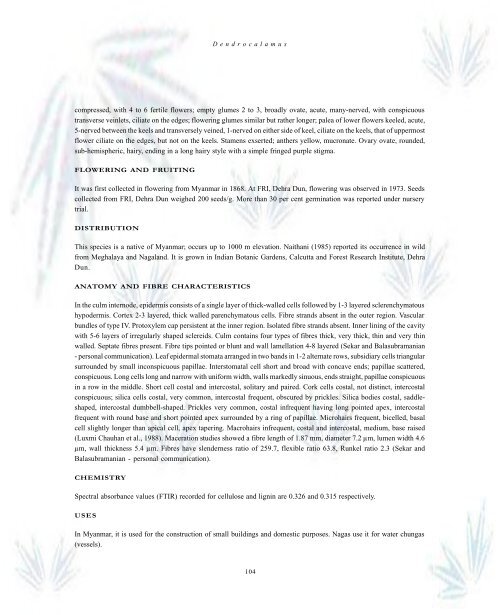Create successful ePaper yourself
Turn your PDF publications into a flip-book with our unique Google optimized e-Paper software.
Dendrocalamus<br />
compressed, with 4 to 6 fertile flowers; empty glumes 2 to 3, broadly ovate, acute, many-nerved, with conspicuous<br />
transverse veinlets, ciliate on the edges; flowering glumes similar but rather longer; palea of lower flowers keeled, acute,<br />
5-nerved between the keels and transversely veined, 1-nerved on either side of keel, ciliate on the keels, that of uppermost<br />
flower ciliate on the edges, but not on the keels. Stamens exserted; anthers yellow, mucronate. Ovary ovate, rounded,<br />
sub-hemispheric, hairy, ending in a long hairy style with a simple fringed purple stigma.<br />
FLOWERING AND FRUITING<br />
It was first collected in flowering from Myanmar in 1868. At FRI, Dehra Dun, flowering was observed in 1973. Seeds<br />
collected from FRI, Dehra Dun weighed 200 seeds/g. More than 30 per cent germination was reported under nursery<br />
trial.<br />
DISTRIBUTION<br />
This species is a native of Myanmar; occurs up to 1000 m elevation. Naithani (1985) reported its occurrence in wild<br />
from Meghalaya and Nagaland. It is grown in Indian Botanic Gardens, Calcutta and Forest Research Institute, Dehra<br />
Dun.<br />
ANATOMY AND FIBRE CHARACTERISTICS<br />
In the culm internode, epidermis consists of a single layer of thick-walled cells followed by 1-3 layered sclerenchymatous<br />
hypodermis. Cortex 2-3 layered, thick walled parenchymatous cells. Fibre strands absent in the outer region. Vascular<br />
bundles of type IV. Protoxylem cap persistent at the inner region. Isolated fibre strands absent. Inner lining of the cavity<br />
with 5-6 layers of irregularly shaped sclereids. Culm contains four types of fibres thick, very thick, thin and very thin<br />
walled. Septate fibres present. Fibre tips pointed or blunt and wall lamellation 4-8 layered (Sekar and Balasubramanian<br />
- personal communication). Leaf epidermal stomata arranged in two bands in 1-2 alternate rows, subsidiary cells triangular<br />
surrounded by small inconspicuous papillae. Interstomatal cell short and broad with concave ends; papillae scattered,<br />
conspicuous. Long cells long and narrow with uniform width, walls markedly sinuous, ends straight, papillae conspicuous<br />
in a row in the middle. Short cell costal and intercostal, solitary and paired. Cork cells costal, not distinct, intercostal<br />
conspicuous; silica cells costal, very common, intercostal frequent, obscured by prickles. Silica bodies costal, saddleshaped,<br />
intercostal dumbbell-shaped. Prickles very common, costal infrequent having long pointed apex, intercostal<br />
frequent with round base and short pointed apex surrounded by a ring of papillae. Microhairs frequent, bicelled, basal<br />
cell slightly longer than apical cell, apex tapering. Macrohairs infrequent, costal and intercostal, medium, base raised<br />
(Luxmi Chauhan et al., 1988). Maceration studies showed a fibre length of 1.87 mm, diameter 7.2 µm, lumen width 4.6<br />
µm, wall thickness 5.4 µm. Fibres have slenderness ratio of 259.7, flexible ratio 63.8, Runkel ratio 2.3 (Sekar and<br />
Balasubramanian - personal communication).<br />
CHEMISTRY<br />
Spectral absorbance values (FTIR) recorded for cellulose and lignin are 0.326 and 0.315 respectively.<br />
USES<br />
In Myanmar, it is used for the construction of small buildings and domestic purposes. Nagas use it for water chungas<br />
(vessels).<br />
104


